For a culture with such a rich history and tradition as Egypt’s, it is pretty ironic that a newcomer “transplant” dish is as ubiquitous and popular as koshary.
And yet, thanks to a fusion of incoming influencing cuisines, it has rapidly become one of the most authentic and recognizable foods in this former bastion of the ancient world.

Koshary and Its “Transplant” History
When it comes to ingredients and flavors, koshary is very eclectic in its make up. While technically a very recognizable Egyptian dish, most of the ingredients aren’t traditionally Egyptian at all!
The genesis of koshary goes back to the late 19th century… a tiny window of time for a nation as deeply rooted and historically significant as Egypt.
The late 1800s marked an interesting period in Egypt’s economic history. Despite being flush with foreign investment and rapidly developing in some sectors (i.e. military and defense), the overall economy was on the brink of total implosion. Feeding on growing discontent with the economy, a group of Arabic and Islamic nationalists opposed to European influence staged a coup in 1882. To keep political stability in the area, the British, French and Indian armies invaded Egypt in order to return the incumbent Prime Minister, Khedive Tewfiq, into power. What ended up actually happening, though, was a 32-year run of British occupation in the area commonly referred to as the “veiled protectorate.”
Over the period of the “veiled protectorate,” the British did introduce a program of systematic investment into key areas of Egypt’s economy – particularly in cotton and other native productive resources – to bring greater financial and economic stability to the nation. During this time, the domestic economy began to pick up pace as Egypt developed into a strong commercial and trade destination in the region.
For the Egyptian people, even those in lower classes, this period of economic boom meant more types of food became abundantly available. Not only were traditional Egyptian produce and foods – wheat, barley, legumes, fruits and vegetables – more readily available, but incoming ingredients from outside cultures also became commonplace as well.
Take rice and macaroni, for example. Both are two of the most common ingredients found in most versions of koshary recipes, but neither are native to Egyptian cuisine. Instead, both rice and macaroni were most likely introduced into Egypt during the “veiled protectorate” by the Italians and Indians, respectively.
Creating Koshary
As for the koshary recipe itself, there are two speculative reasons for how the concept of this “fusion transplant” cuisine came to be:
- In the increasingly diverse pantry of a lower class Egyptian citizen, families would usually have a little bit left of every type of ingredient found in koshary – rice, macaroni, lentils, tomato sauce, onions, etc – and would combine it all into one big, hearty and very inexpensive dish.
- Deriving inspiration from the recipe of another British colony, British occupants in Egypt introduced a localized version of khichdi, an Indian dish made of cooked rice and lentils, that they could assuredly safely eat instead of local food. Over time, the localized khichdi integrated other components like macaroni and the tomato sauce that are key to today’s koshary.
Whatever the true catalyst for koshary’s creation, it has quickly developed into one of the most ubiquitous and widely popular foods served all over. Whether it be higher-end restaurants to the corner street pushcart, chances are good that each is serving their own version of koshary.
Yes… for all its recency and abundance of “transplanted” ingredients, koshary is as Egyptian as it gets.
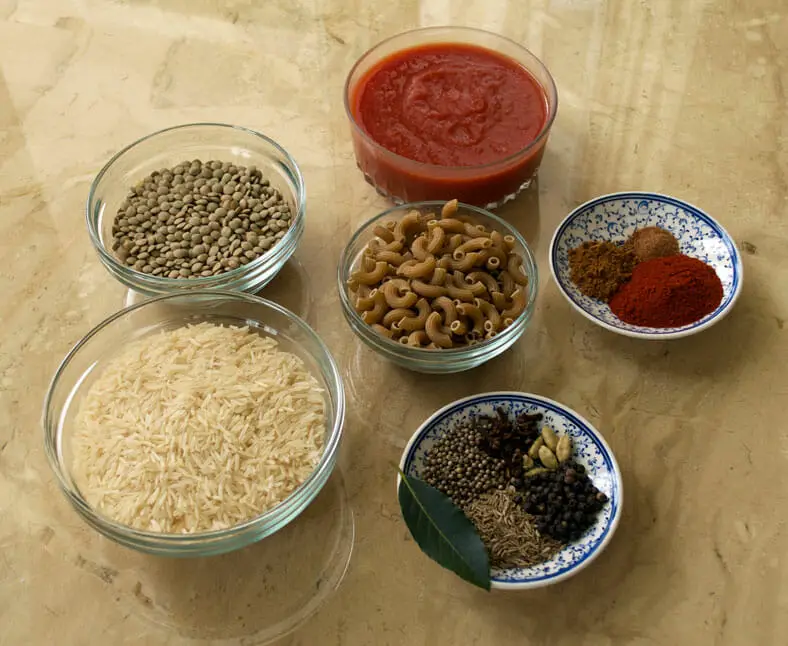
About the Recipe
Technically, koshary itself isn’t necessarily one singular recipe but rather an aggregation of separate components that happen to be plated together. And while most every component is optional, what is required for koshary are the base of rice and lentils. Rice and lentils, ideally cooked in a flavored broth, are what make up the base essence of koshary, and you most likely won’t find very much variation in this area (we didn’t).

From there, what you add into your koshary is completely dependent on your own preferences. That, oddly enough, is the beauty of the recipe itself. There are several other very common pieces to the koshary puzzle, but these are more considered preferential enhancements versus true requirements to the dish.
First, there’s the pasta. Many versions of koshary will have some sort of pasta either as a garnish or as part of the rice-lentil base. Again, its prominence in the recipe is completely up to the cook. The most usual types of pasta used in koshary are either macaroni or elbow pasta, but we found even spaghetti and linguine used as well. It really is up to you.
Next, there’s the sauce, which is where the koshary gets most of its flavor. Made from a base of crushed tomatoes, the sauce is flavored with garlic, vinegar and often with an array of spices to add a bite to the sauce. Depending on which recipe you come across, the sauce for koshary might include something called baharat, which literally just means “spice” in Arabic. The inclusion of baharat into a koshary sauce simply implies that there are spices added to the sauce… what actually goes into the mixture can be, again, up to the chef.
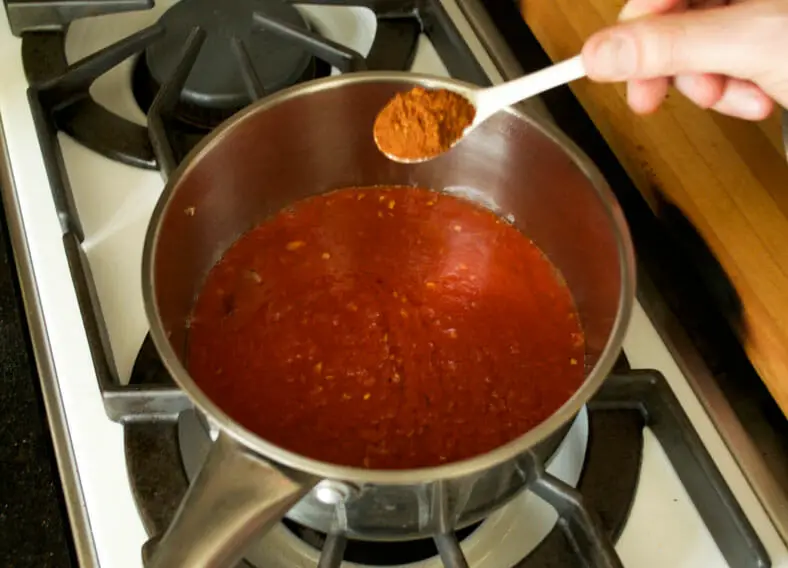
Finally, there are the additional garnishes. Some very common garnishes to have with koshary include fried onions, cooked chickpeas, fried bread, fresh salad and sometimes even minced beef. When not topped with something like beef, however, koshary is actually an ideal dish for vegetarians, vegans and for those observing religious fast days. This versatility and flexibility of the recipe might be one reason why koshary became as popular as it did amongst a diverse Egyptian population.
Given the deconstructed nature of the recipe, the process to make koshary from scratch can be a bit hectic. To make the base starches and the sauce and the toppings for serving at the same time, there will inevitably be several different cooking processes done in parallel. You’ll see in the recipe below what exactly we mean and how this actually gets done, but rest assured you’ll certainly be bopping around your kitchen and tending to multiple pots while making koshary.
Our Take on the Recipe
Given that our original reference recipe comes from one of Egypt’s most renowned chefs and a professed koshary lover, there were very few major changes we made to the root recipe.
First, a note about one particular approach and tactic that we absolutely loved from Chef Osama El Sayed: flavoring the oil with onions. Since his version of koshary was going to have fried onions as a topping anyways, his cooking process began with frying onions, which left an abundance of olive oil flavored and leftover for the rest of the cooking process.

When it came to spicing the sauce, we opted to make a homemade spice mixture of baharat. Again, technically broadly meaning “spice” in English, we made our particular version of baharat to include a collection of potent-flavored seeds like cumin, coriander, cloves and cardamom. After an initial dry roasting of the seeds in a hot pan, they were added together with with smoked paprika, nutmeg and cinnamon into a spice grinder. What resulted was a spicy yet tangy mixture – both to the palate and the nose – that really livened up our tomato sauce and the koshary as a whole.

Next, in the absence of true Egyptian rice, we opted to use basmati rice in our version. If you don’t have Egyptian rice available, any sort of short grain rice will do.

Other than that, we adjusted very little to a true master’s recipe, and we’re glad we did. Especially when filled with both fresh and fried toppings, koshary is a powerful mixture of diverse and flavorful taste of modern day influences on Egyptian cuisine.
What do you add to your koshary? Comment below!
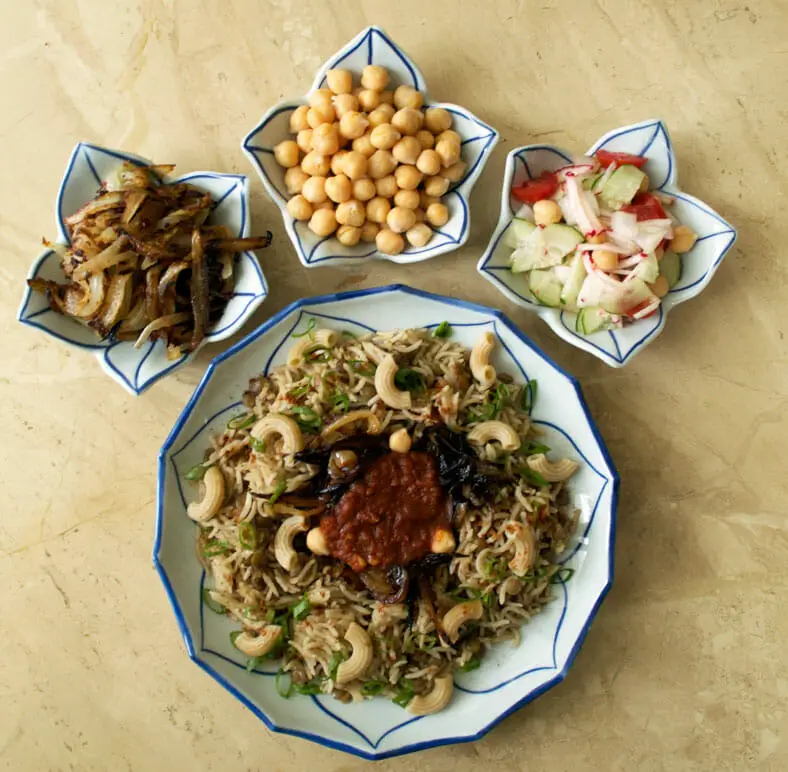

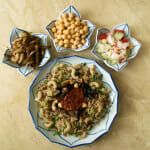
Koshary
- Total Time: 1 hour 10 minutes
- Yield: 6 people 1x
Description
Koshary in Egyptian rice.
Ingredients
Koshary
- 2 onions, cut into thin slices for frying (for crispier fried onions, toss in 1 tablespoon of chickpea flour)
- ½ cup olive oil
- 1½ cups Egyptian rice (or any short grain rice substitute)
- 1½ cups lentils, preferably brown
- 5 cups of water or vegetable broth
- 1 bay leaf
- 1 teaspoon baharat
- 1 teaspoon black pepper
- 1 teaspoon sea salt
- 1 cup of elbow macaroni (optional)
Sauce
- 4 cloves of garlic, minced
- 3 cups crushed tomatoes
- 1 tablespoon baharat
- 1 teaspoon crushed red chili flakes (optional)
- 1 teaspoon sea salt
- 1 tablespoon red wine vinegar (or any other vinegar with at least 5% acidity)
Baharat Spice Mixture
- 1 tablespoon whole black peppercorns
- 1 teaspoon cumin seeds
- 1 teaspoon coriander seeds
- 1 teaspoon whole cloves
- 1 teaspoon cardamom seeds
- 2 teaspoons paprika
- 1 teaspoon ground cinnamon
- 1 teaspoon ground nutmeg
Instructions
Stage 1 – Make the Baharat
- Bring a medium-sized sauce pot over medium-high heat
- Once hot, add cumin seeds, black peppercorns, coriander seeds, whole cloves, and cardamom seeds. Toast the seeds until they start to become fragrant (about ~1 minute)
- Transfer the seeds from your pot into a spice grinder with the paprika, cinnamon and nutmeg and grind together until it has the consistency of a fine powder
- Set aside your sauce pot but don’t wash – you’ll be using it later
Stage 2 – Frying Onions
- In a large stockpot, heat your olive oil over high heat and, when very hot, add the thinly sliced onions
- Fry the onions until golden brown (~10 minutes), then set the onions aside on a plate lined with a paper towel. Be sure to keep the flavored olive oil – you’ll be cooking the rest of your koshary with it!
Stage 3 – Koshary
- In the same stockpot as your onions were fried, first remove a little bit of the onion-flavored olive oil
- Next, put the stockpot back over medium high heat and, once the oil is reheated, add the lentils, 1 teaspoon of baharat and your bay leaf. Fry for ~2 minutes
- After 2 minutes, add 3 cups of vegetable broth/water and submerge the lentils
- Bring the liquid to a boil before reducing heat to a simmer. Let the lentils simmer for 20 minutes
Stage 4 – Sauce
- As the lentils are simmering, bring your sauce pot used for your baharat back to medium-high heat. Add some of the onion-flavored olive oil to the sauce pot
- Once the olive oil is reheated, add the garlic and fry until golden brown (2-3 minutes)
- As garlic turns golden brown, add the crushed tomatoes, 1 tablespoon of baharat, red chili flakes and sea salt. Bring to a boil before reducing heat to a simmer. Let the sauce then simmer for 10 minutes
- After 10 minutes, taste and season accordingly with extra salt and pepper
- Then, add the vinegar and simmer for another 5 minutes. Take off the heat when done
Stage 5 – Finishing Koshary
- At this point, the lentils will have begun to cook through. Add rice and another 2 cups of broth/water to re-submerge. Let simmer for another 20 minutes
Stage 6 – Macaroni and Other Garnishes
- For the final 20 minutes as the rice simmers, use the time to prepare additional garnishes and toppings for your koshary
- If making elbow macaroni, cook according to instructions and set aside
Stage 7 – Bringing It All Together
- To serve, start with a base of koshary. Add as much sauce as desired followed by additional toppings as you like. And be sure to make abundant use of the fried onions. Enjoy!
- Prep Time: 15 mins
- Cook Time: 55 mins
- Category: Main Dishes
- Cuisine: Egyptian
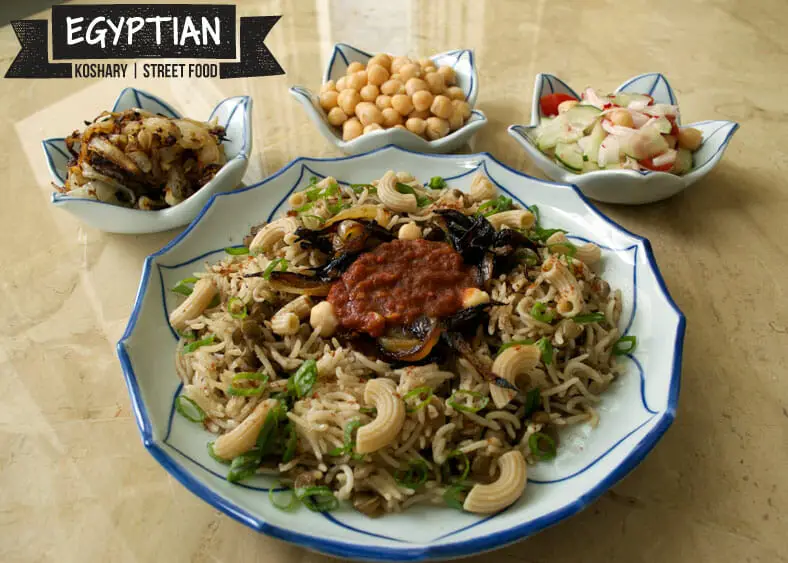

1 thought on “Koshary”